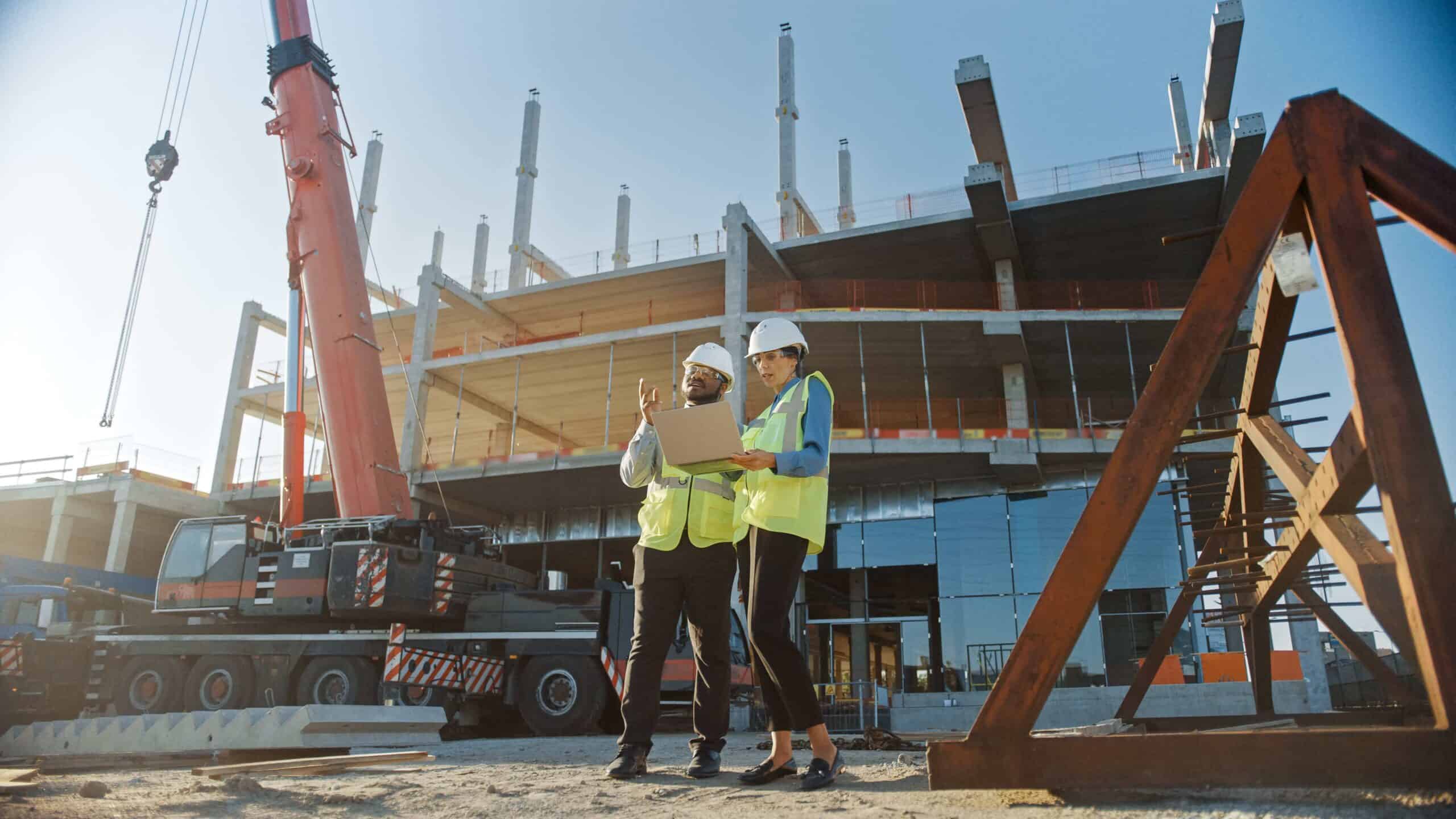The COVID-19 pandemic has been a catalyst for change in the construction sector.
Since COVID-19 was first discovered in December 2019 in Wuhan, China, it has spread rapidly across the globe. Once the WHO declared it a pandemic, many countries went into lockdown to curb the spread of the virus. While lockdowns have been fairly effective in reducing the number of infections, they have also put tremendous pressure on the world’s economy. Millions of people lost their jobs, thousands of businesses have closed for good, and entire industries have been devastated. The resulting recession will possibly be the most severe the world has ever experienced. So, what does that mean for the future of construction? Is there anything businesses can do to turn the tide?
The impact of the crisis on construction in the EU
The novel coronavirus had a significant impact on the European construction industry. According to a survey conducted in March 2020, 32 per cent of respondents from the construction equipment industry experienced a slowdown in production, while 30 per cent witnessed factory closures. Although the European construction market experienced an abrupt downturn, the industry is starting to show signs of recovery. The EU construction sector saw its production increase by 21.2 per cent in May 2020, with the biggest gains reported in Italy and France. However, European construction activity in May is still only 89.1 per cent of what it had been at the beginning of the year. Euroconstruct predicts that the construction industry will witness a full recovery in 2022, but it will lose at least €300 billion in total output along the way.
What we have learned from previous recessions and crises
History tends to repeat itself, so when planning your company’s future, it’s always helpful to look to the past and try to learn from previous missteps. If we take a trip down the memory lane and recall the Great Recession, we can see that the 2008–2009 crisis impacted all kinds of businesses and caused immense damage across industries. Not surprisingly, the construction sector wasn’t left untouched. The total value of the construction work dropped by almost 40 per cent, while 150,000 construction businesses had to shut down. Before the recession, this industry was on an upward trajectory and seemed destined to continue growing in the future. However, once the Great Recession arrived, a number of builders were forced to either sell their businesses, merge with others, or shut down.
For some businesses, the Great Recession presented a perfect opportunity to expand into new markets and explore other related areas within the industry. Some decided to widen their product offerings and test new construction solutions and methods, which proved to be a better fit than traditional ones. Others chose to modify their marketing programs to provide concerned buyers with a peace of mind. Just like the Great Recession, the slowdown triggered by the pandemic has brought some new challenges, but companies willing to take a calculated risk should be able to turn those challenges into opportunities.
Structural ways the coronavirus crisis is changing construction
The coronavirus pandemic has brought new and unprecedented challenges that are bound to accelerate long-term structural changes in the construction sector. To keep workers safe on the construction site, construction companies have implemented a variety of new jobsite policies. Frequent disinfection, temperature checks, and staggered shifts are just some of the ways companies are trying to prevent the spread of the virus. In many countries, there are now new regulations in place that require construction workers to maintain a safe distance on-site. Since it’s easier to monitor social distancing in a controlled environment, McKinsey & Company predicts that interest in off-site construction could increase in the future. As contractors push fabrication off-site, manufacturers are expected to expand their range of prefabricated subassemblies.
Although construction is recognised as one of the least digitised industries, it’s evident that the pandemic has accelerated the sector’s digital transformation. Engineers are increasingly adopting digital collaboration tools, while contractors are turning to 4D and 5D simulation to enhance the project planning process. Wearable devices and sensor technology enable contractors to track productivity, as well as monitor the utilisation of materials and equipment on the site.
The pandemic has also forced companies to start experimenting with different business models and values, leading to the emergence of new construction industry archetypes. One of these new models is vertical integration. A recent report from a management consulting firm highlights that “vertical integration (which may include a return to greater reliance on direct labor) is a potential route to greater resilience” in a post-crisis world.
Visions for the future of construction
When an economic crisis hits, vulnerable groups such as women, refugees, people suffering from disabilities, and long-term unemployed people, are usually the first to be fired and probably the last to be re-hired. Martin Loosemore, Professor of Construction Management at the University of Technology Sydney, believes the solution to this problem lies in the construction sector. The industry is one of the world’s biggest employers and provides a plethora of jobs for all levels of society.
To prevent the spread of the virus on the construction site, workers are advised to maintain a safe physical distance from each other. However, Jack Dennerlein, a professor at the Harvard School of Public Health, thinks that social distancing increases the risk of injury at construction sites. “The industry really relies on the buddy system as an extra set of eyes, and the social distancing requirements might put them at risk not for the virus but for an injury or accident to occur.”
Trendwatcher and futurist Richard van Hooijdonk believes that cutting edge technology will drastically change the construction landscape and bring many new opportunities to the industry. Construction robots will take over difficult and time-intensive tasks, making the industry more efficient and reducing the number of accidents. Augmented and virtual reality will change how we design buildings and reduce the number of costly errors. Blockchain will also have a role to play, allowing construction companies to automate contractual processes and eliminate disputes. To meet the demand for stronger and more durable construction, companies will experiment with advanced materials that allow buildings to heal themselves.
In the next ten years, skyscrapers will continue to grow in size and they will get some new features, predicts futurist Steve Brown. Buildings will also be equipped with 5G connectivity and thousands of sensors, allowing the city to respond to its inhabitants’ needs in real time and making them cleaner and safer places to live in. A prolific speaker and futurist, Jack Uldrich believes advances in technologies like AI, robotics, 3D printing, blockchain, and VR/AR, as well as trends like peer-to-peer lending and gig economy, will shape the future of the construction industry. “The faster we can recognize potential changes in technology, the better-prepared the construction industry will be in the long run,” explains Uldrich.
Recession strategies
To survive the crisis, the construction industry, just like every other sector, needs to devise more effective strategies. Many companies try to get as much work as they can during an economic recovery. But this approach can hurt a business. In fact, research suggests that construction businesses are three times more likely to fail during a recovery process than a recession. Therefore, it’s essential that construction companies start slow and carefully select which projects to take on next.
While public projects can bring more cash than private jobs, they also bring their own challenges and requirements. For example, contract negotiations for private projects are quite different from those for government-funded public projects and require construction companies to familiarise themselves with the construction bond process, which provides financial security. In times of crisis, construction companies often get into a rut because they are too afraid to think outside the box and explore other options. This fear can make these companies miss opportunities for future growth. However, if they focus on diversification, their recovery could go a lot smoother.
The pandemic has shown just how important it is for construction companies to digitise their processes. Since construction-related digital tools are expected to continue to rise in popularity, we are likely to see companies accelerating their digitalisation efforts and adapting their strategies along the way. Digital by Default: Construction after COVID-19 report reveals that 95 per cent of construction companies have witnessed an increase in digital tech use due to pandemic.
Cases & experiments
As the coronavirus continues to spread across the world, construction companies need to take every precaution to protect their workforce and make sure job sites are as safe as possible. Due to the nature of the work carried out at construction sites, adhering to the new safety rules isn’t always easy, though. This is why numerous companies are exploring the use of AI and the IoT to monitor their workers in real-time and make sure they’re practising social distancing. WorkerSense, for instance, has embedded workers’ hard hats with microchips that monitor whether they are properly distancing themselves from one another. When workers get closer than two metres to each other, the sensor detects it and immediately sends an alert.
Realising the need for more sustainable construction processes, authorities are increasingly urging companies to deploy electric vehicles and equipment at construction sites. For instance, in Norway’s capital Oslo, authorities have banned the use of fossil fuel-powered construction machinery on all new public building projects. As a result, the Swiss company Suncar HK recently deployed its electric excavator at one construction site in the city. Another effective way to reduce the industry’s carbon footprint is by recycling building materials. Steel, brick, and timber, for instance, can all be reused in future projects. Shocked by statistics that reveal the scale of construction waste, Maayke-Aimée Damen decided to launch the Excess Materials Exchange (EME), which serves as a marketplace for spare materials and allows construction companies to find new reuse options for their waste products.
Many technologies exploded in popularity during the pandemic-enforced lockdown and chances are some of them will continue to thrive even after the virus is long gone. Virtual meetings, for instance, proved rather helpful in times when social distancing became the norm and this utility could extend to the field of construction as well. Public meetings are an important part of public projects as they enable construction companies to engage with the public and discuss the impact of their projects. But AECOM’s platform takes public meetings to a whole new level by placing community members into a virtual town hall, where they can read information panels, view maps, watch videos, and offer feedback.
The majority of construction managers believe that platforms will play a pivotal role in post-coronavirus operations within the construction sector. There are a plethora of construction platforms on the market to choose from. LetsBuild, for instance, allows users to track and update their project plans in real time, as well as receive project overviews and insights.
The future of construction
Construction is widely regarded as one of the world’s most dangerous occupations, in which serious injury or even death is a rather common occurrence. To improve safety at construction sites and protect employees from harm, construction companies are increasingly turning to technology for help. Exoskeletons, for instance, enhance construction workers’ strength and endurance, enabling them to lift heavier loads and remain in unnatural positions for prolonged periods without suffering an injury.
Unlike traditional construction methods, which are mostly restricted to square and rectangular shapes, 3D allows you to create incredibly complex shapes and structures, which are only limited by your imagination. 4D printing, on the other hand, offers some even more mind-blowing capabilities by allowing you to create shape-shifting structures, forever changing how we approach design. Not far from now, the buildings we live in will be made of self-healing materials capable of repairing cracks in the concrete or any other type of damage the building may sustain.
Digital twins are another innovation shaping the future of construction. They enable construction companies to create digital replicas of physical structures and identify potential issues before actually building them.
Final thoughts
The growing labour shortage is one of the biggest issues currently facing the construction industry, forcing construction companies to explore the possibility of adopting robotic systems and leverage cutting-edge solutions. To survive the crisis, the construction industry, just like every other sector, needs to devise a more effective plan of action. With the right strategy, construction companies will be able to expand their business operations and sustain growth in the global construction market




